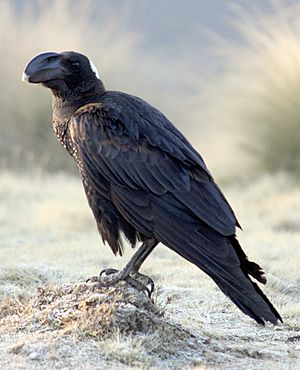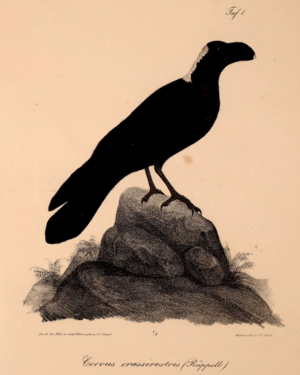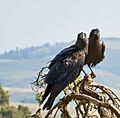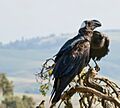Thick-billed raven facts for kids
Quick facts for kids Thick-billed raven |
|
|---|---|
 |
|
| In Ethiopia | |
| Conservation status | |
| Scientific classification | |
| Genus: |
Corvus
|
| Species: |
crassirostris
|
 |
|
The thick-billed raven (its scientific name is Corvus crassirostris) is a very special bird from the Horn of Africa. It's part of the corvid family, which includes crows and jays. This raven is one of the biggest birds in its family! In fact, it's one of the largest passerines (which are also called "perching birds") in the world.
These ravens are usually about 64 cm (25 in) long, but they can range from 60 to 70 cm (24 to 28 in). Female thick-billed ravens weigh around 1.15 kg (2.5 lb), while males are a bit heavier, weighing about 1.5 kg (3.3 lb). This makes them one of the heaviest perching birds alive today!
The thick-billed raven has a very unique and large bill. It's flat on the sides and curves deeply, making it look very distinctive. This bill is the biggest of any perching bird, measuring about 8–9 cm (3.1–3.5 in) long! It's black with a white tip. The raven's head, throat, and neck have very short feathers. The throat and upper chest look a bit shiny and brownish, but the rest of the bird is a glossy black. There's also a clear white patch of feathers on the back of its neck.
Contents
Where Do Thick-Billed Ravens Live?
These amazing birds live in countries like Eritrea, Somalia, and Ethiopia. They prefer to live in mountains and high plateau areas. You can find them at high elevations, usually between 1,500 and 3,400 meters (about 4,900 to 11,000 feet) above sea level. They are special because they are only found in this part of northeastern tropical Africa.
How Thick-Billed Ravens Behave
What Do Thick-Billed Ravens Eat?
Thick-billed ravens eat many different things, which means they are omnivores. They enjoy eating grubs (which are like small worms), beetle larvae found in animal dung, and even leftover meat scraps or human food. They have also been seen eating wheat from fields. When they look for food in animal dung, they use a special sweeping motion to spread the dung and find the tasty grubs hidden inside.
Nesting and Raising Young
These ravens build their nests in trees or on cliffs. Their nests are usually made of sticks, similar to the nests of the white-necked raven. Female thick-billed ravens lay three to five eggs. Sometimes, these ravens are very protective of their nests. For example, they have been seen bravely chasing away large, predatory Verreaux's eagle owls from their nesting areas!
The Voice of the Raven
Thick-billed ravens make several different sounds. They can let out a harsh, nasal croak, or a low, wheezy croak. Sometimes they make a sound that sounds like "raven-raven," and other times a "dink, dink, dink" sound. Like many birds in the corvid family, thick-billed ravens can copy other sounds. However, they usually only do this when they are kept by humans, not often in the wild.
Gallery









